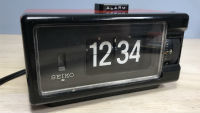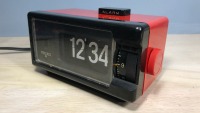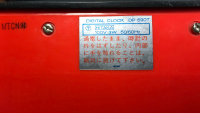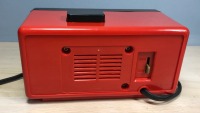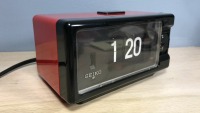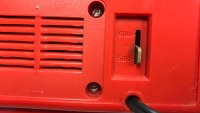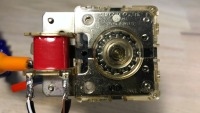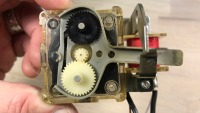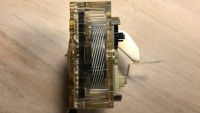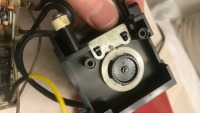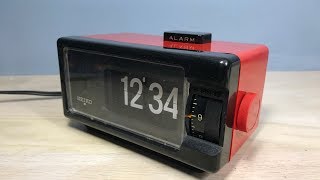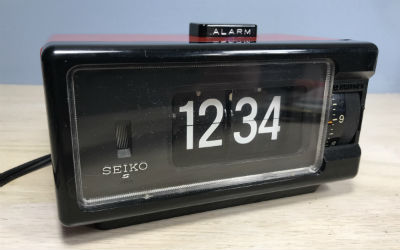 The Seiko DP 690T is an alarm flip clock made in Japan specifically for the Japanese market. The clock is a striking, yet simple, rectangular, small flip clock with bold red and black colors featuring the standard black tiles with white digits. The wheel shaped alarm selector can be found directly at the front of the clock and is rolled upward to set the desired alarm time. To set the alarm, the alarm selector on the top of the clock must be pressed so that it extends above the case of the clock, clearly displaying the work "alarm" in white print. While not immediately apparent, you will soon discover that this is an old-style, 12 hour only clock. That is, there is no AM or PM. If you set the alarm for 7:00, it will alarm at both 7 AM and 7 PM. This would probably not be a problem, since once the alarm sounds, it will sound continuously for 20 minutes or more, most likely ensuring that you'll press the alarm button.
The Seiko DP 690T is an alarm flip clock made in Japan specifically for the Japanese market. The clock is a striking, yet simple, rectangular, small flip clock with bold red and black colors featuring the standard black tiles with white digits. The wheel shaped alarm selector can be found directly at the front of the clock and is rolled upward to set the desired alarm time. To set the alarm, the alarm selector on the top of the clock must be pressed so that it extends above the case of the clock, clearly displaying the work "alarm" in white print. While not immediately apparent, you will soon discover that this is an old-style, 12 hour only clock. That is, there is no AM or PM. If you set the alarm for 7:00, it will alarm at both 7 AM and 7 PM. This would probably not be a problem, since once the alarm sounds, it will sound continuously for 20 minutes or more, most likely ensuring that you'll press the alarm button.
It may be curious that the clock has the words "alarm" on the button in English, and yet, supposedly, this is a a clock for the Japanese market. However, it is important to note that mixing English and Japanese has not been that uncommon in modern Japan. Also, in the day, Japan had a budding, international manufacturing economy. This included the rival Copal company making a huge splash in the making of camera shutters as well as leading the world in making flip clock mechanisms. But two items clearly show this to be a Japanese clock for the Japanese people. The warning label on the bottom written in Japanese and the 50/60 Hz selector switch on the back.
Firstly, the red warning label appears in Japanese. Up until FlipClockFans.com got involved, many English speaking reviewers simply ignored this, but we took the time to get this translated ... and it's good advice.
The Japanese:
通電したまま、時計の枠を外したり、内部に手を触れることは、絶対に避けてください。
is spoken in Japanese in the following way (not necessary to know, but interesting):
Translated into English, this means
Don't remove the frame of the watch (clock) or touch the inside while keeping the power on.
It's curious that the translator said "watch" instead of "clock." The Japanese kanji characters 時計, strictly mean "time keeping device" but many translate this into the English "watch." A japanese person today may just say クロック (kurokku) if they want to say clock specifically.
A little bit about the Japanese Language
While this is way off topic, I just have to say that it seems fascinating that the Japanese have an extraordinary written language. There are four different written ways to communicate Japanese. First, Kanji - this is the ancient Chinese-type characters with each single character conveying a word or complete meaning. We saw this earlier with the word for time keeping device, 時計. Next, Hiragana - these are the beautiful, flowing characters of Japanese. On the warning label what is translated as "remove" is written as を外したり in Hiragana. This is one of the writing styles that are more akin to our alphabet, but not exactly. You'll find that the Japanese language is communicated using a phonetic writing system. For example, in English we have a hard "K" sound like in the word clock. The closest that you will get to this is the Japanese く , which would be pronounced "Ku or Koo." Now the other way to write the same phonetic sounds is katakana. These symbols represent the exact same sounds as Hiragana, but in a completely different writing style. Any foreign word that is assimilated into the Japanese language will be written with katakana. Yes, these words could as easily be written with Hiragana, but it's just not the practice. It's a clear way to show an assimilated term. For example to say "flip clock" the Japanese would write フリップクロック Now listen to this being pronounced a few times:
meaning. We saw this earlier with the word for time keeping device, 時計. Next, Hiragana - these are the beautiful, flowing characters of Japanese. On the warning label what is translated as "remove" is written as を外したり in Hiragana. This is one of the writing styles that are more akin to our alphabet, but not exactly. You'll find that the Japanese language is communicated using a phonetic writing system. For example, in English we have a hard "K" sound like in the word clock. The closest that you will get to this is the Japanese く , which would be pronounced "Ku or Koo." Now the other way to write the same phonetic sounds is katakana. These symbols represent the exact same sounds as Hiragana, but in a completely different writing style. Any foreign word that is assimilated into the Japanese language will be written with katakana. Yes, these words could as easily be written with Hiragana, but it's just not the practice. It's a clear way to show an assimilated term. For example to say "flip clock" the Japanese would write フリップクロック Now listen to this being pronounced a few times:
Yes, it sounds like the speaker is trying but failing to properly say "flip clock." But you must realize, that this is not what is happening at all. The word, when written フリップクロック is now an assimilated Japanese word, formed using their phonetic writing system and speaking style. Using the English alphabet (otherwise known as the "Roman" alphabet) this word is spelled "furippukurokku" - this is called Romanized Japanese (more on this later). As an illustration, remember that there is no isolated hard "K" sound in Japanese. So if you listen again to the pronunciation above, you'll hear "ku" at the end of "clock." The same applies to our other consonant sounds like "F." And, there really is no true "L" sound at all in Japanese. So you get "furippukurokku." This is all nice and good ... but in practice, most often, Japanese will refer to a flip clock as パタパタ時計 (Patapata tokei). That's why sometimes on ebay you'll see a listing for a "Pata Pata" flip clock. It seems パタパタis a form of onomatopoeia (a word that phonetically imitates, resembles, or suggests the sound that it describes) - like pata pata may be a way to describe what a flip clock sounds like. So, in practice (for example on Japanese auction sites), you'll do better to search for パタパタ時計 if you're looking for flip clocks.
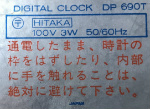 You may noticed that the warning label contains both Kanji and Hiragana. This is typical. In fact, it wouldn't be at all unusual to see the inclusion of all three styles in written Japanese as well with some English as well (this is common in direction booklets). But you will definitely not see the next way to write Japanese mixed in with these three.
You may noticed that the warning label contains both Kanji and Hiragana. This is typical. In fact, it wouldn't be at all unusual to see the inclusion of all three styles in written Japanese as well with some English as well (this is common in direction booklets). But you will definitely not see the next way to write Japanese mixed in with these three.
The fourth and final way to write Japanese is using the previously mentioned Romanized Japanese - using the English alphabet to write out the word, essentially as spoken by an English speaking person, the way it is pronounced by a native speaking Japanese person. As already mentioned a good example would be "furippukurokku" (フリップクロック) to mean flip clock. Romanized Japanese is often used when teaching Japanese to English speakers. And if you're wondering - Yes, Japan could replace their whole, complicated language with this writing style ... and there have been movements in Japan to do exactly this. But don't hold your breath. The traditional way of communication is strongly held to in Japan and will not likely change in our lifetime (or our children's children's children's lifetime for that matter).
And finally, it may be interesting to learn that the Japanese language is structurally very unlike English. When translating English to and from a Romance language (Spanish, Portuguese, French, Italian, and Romanian) or a Germanic language (Danish, Swedish, Icelandic, Norwegian), there is often nearly a one-to-one translation, with the ordering a little different as far as the adjectives, and other slight differences. However, Japanese is altogether different from English. If you begin from left to right translating the label, 通電したまま、時計の枠を外したり、内部に手を触れることは、絶対に避けてください。 you will get "With energization, remove the frame of the clock, to touch the inside, please avoid absolutely." Japanese is a whole different ballgame altogether.
A clock made specifically for Japan
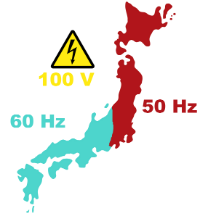 But let's get back to this furippukurokku! The other features of Seiko DP 690T that clearly show it to be a flip clock specifically for the Japanese market, is the rated voltage of 100 V (verses 120 in the US) and the 50/60 Hz selector switch. Japan is unique in the whole world in that the electrical grid is run with 100 V. As you know, in North American and many parts of Southern America (as well as other places throughout the world) we run on 120 V at 60 Hz. This is in contrast to most of the world that runs on 220 V at 50 Hz. Converting electricity for flip clocks becomes a serious challenge, because not only must you convert the voltage, you must change the frequency of the current or your clock will not keep time. The reason for this is that most vintage flip clocks use synchronous motors. These motors depend upon the frequency of the electricity used to keep time. When current comes in at 60 Hz, that means the current alternates direction 60 times a second. When you get a motor spinning using this current, it will keep pace with this frequency. Using gear trains, the clock makers translate this rotational movement into flipping action. What makes Japan's electrical grid curious, to say the least, is that it is actually two grids, one in the western part of the country running at 50 Hz and the rest running at 60 Hz. These grids cannot combine without first being changed to direct current, then back to alternating current at the appropriate frequency. Along the border where the 50/60 Hz change happens are these converting stations. You see, for efficiency, current that an area does not use is shared with the rest of the grid. This is done extensively in the US and at times we even share electricity with Canada, believe it or not.
But let's get back to this furippukurokku! The other features of Seiko DP 690T that clearly show it to be a flip clock specifically for the Japanese market, is the rated voltage of 100 V (verses 120 in the US) and the 50/60 Hz selector switch. Japan is unique in the whole world in that the electrical grid is run with 100 V. As you know, in North American and many parts of Southern America (as well as other places throughout the world) we run on 120 V at 60 Hz. This is in contrast to most of the world that runs on 220 V at 50 Hz. Converting electricity for flip clocks becomes a serious challenge, because not only must you convert the voltage, you must change the frequency of the current or your clock will not keep time. The reason for this is that most vintage flip clocks use synchronous motors. These motors depend upon the frequency of the electricity used to keep time. When current comes in at 60 Hz, that means the current alternates direction 60 times a second. When you get a motor spinning using this current, it will keep pace with this frequency. Using gear trains, the clock makers translate this rotational movement into flipping action. What makes Japan's electrical grid curious, to say the least, is that it is actually two grids, one in the western part of the country running at 50 Hz and the rest running at 60 Hz. These grids cannot combine without first being changed to direct current, then back to alternating current at the appropriate frequency. Along the border where the 50/60 Hz change happens are these converting stations. You see, for efficiency, current that an area does not use is shared with the rest of the grid. This is done extensively in the US and at times we even share electricity with Canada, believe it or not.
So why does Japan have two grids operating at different frequencies? Electricity was introduced to the country first to individual cities - some importing the generators from European countries (Initially Germany, offering the 50 Hz variety) and others getting US Westinghouse generators (at 60 Hz). As the grids expanded, spreading electricity throughout the country, it seems switching over to one or the other by was resisted, due to the cost involved. So, two separate grids evolved over time. Why 100 Volts? Initially, that is what the US brought in. 100 V was considered more safe than 110-120 V and it was thought that electrical components would last longer at that voltage. In 1914 it was decided that 100 would be the national standard.
The burning question about this clock - can it be used in the USA without a transformer to step down the current to 100 Volts. The short answer is yes. Using more complex Japanese electronics in the US would clearly require a transformer and most Japanese will bring such a device when traveling to the US. However, in the Seiko DP 690T, the only electrical component is the coil. Overpowering a simple coil may not have the same consequences. Experience shows that when running the clock on 120 V and with the clock set to 60 Hz the clock functions and keeps time well. But as we alluded to earlier, it may have a shortened life span running at 120 Volts. This is a complete unknown and open to conjecture.
Powering the Seiko DP 690T
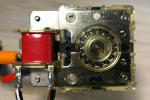 The motor and alarm of the Seiko DP 690T can be described as both economical and yet primitive in a way. The clock has an electric coil that sets up a rotating magnetic field (rmf) to get the rotor spinning. It's a different set up than later, now more common vintage clocks, but a similar set up was also used in some early GE and Panasonic flip clocks. However, also coming right off this coil are two bars that when brought together, buzz annoyingly, serving as the alarm. When these bars are maladjusted, you'll get a continuous hum from the clock. Additionally, if the clock is subjected to impact (dropping for example) you may end up with a permanent hum from the bars that set up the rmf. So, do not drop this clock!
The motor and alarm of the Seiko DP 690T can be described as both economical and yet primitive in a way. The clock has an electric coil that sets up a rotating magnetic field (rmf) to get the rotor spinning. It's a different set up than later, now more common vintage clocks, but a similar set up was also used in some early GE and Panasonic flip clocks. However, also coming right off this coil are two bars that when brought together, buzz annoyingly, serving as the alarm. When these bars are maladjusted, you'll get a continuous hum from the clock. Additionally, if the clock is subjected to impact (dropping for example) you may end up with a permanent hum from the bars that set up the rmf. So, do not drop this clock!
The Seiko DP 690T alarm flip clock
In summary, in the Seiko DP 690T you have an early Japanese alarm flip clock that's stylish, but primitive and subject to humming. It'd be a great addition to a large flip clock collection or any collector of Seiko clocks, yet not recommend as a first flip clock.Clock Information
Name: Seiko Alarm ClockType: Alarm Flip Clock
Power: 100 Volts at 50 or 60Hz (user selectable)
Manufacturer: Hattori Seiko Co., Ltd (now Seiko Corporation)
See the Forum Post to comment.

